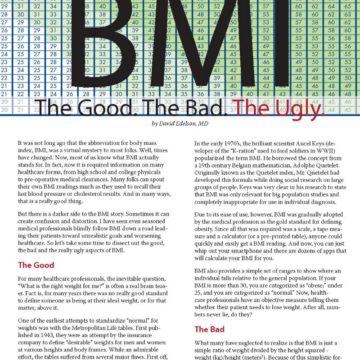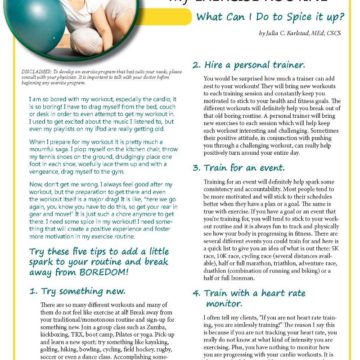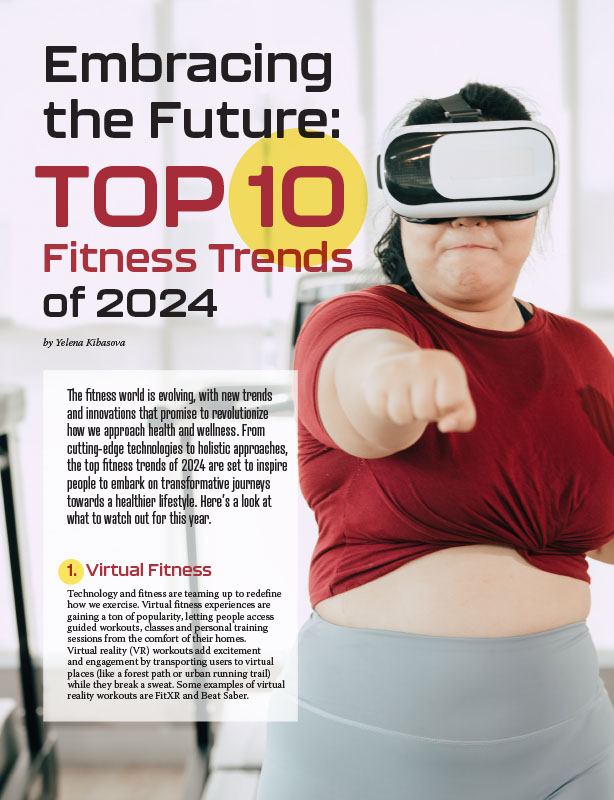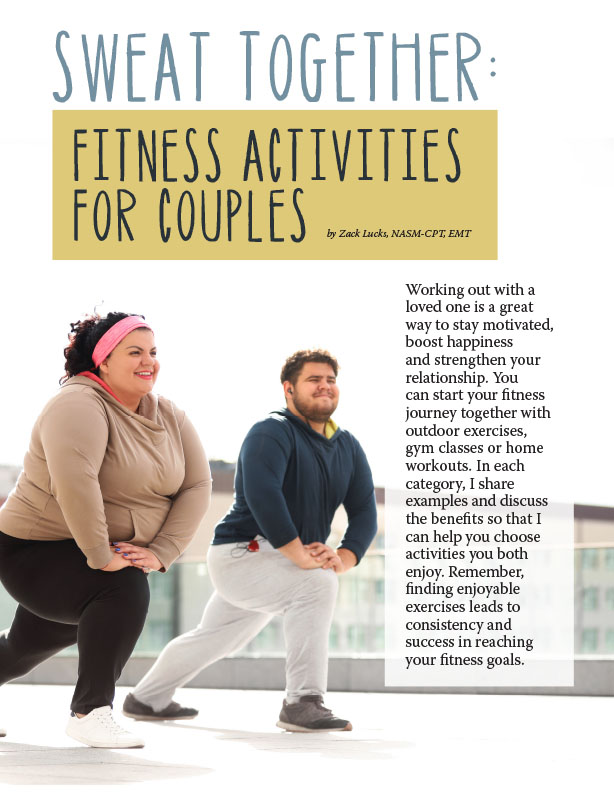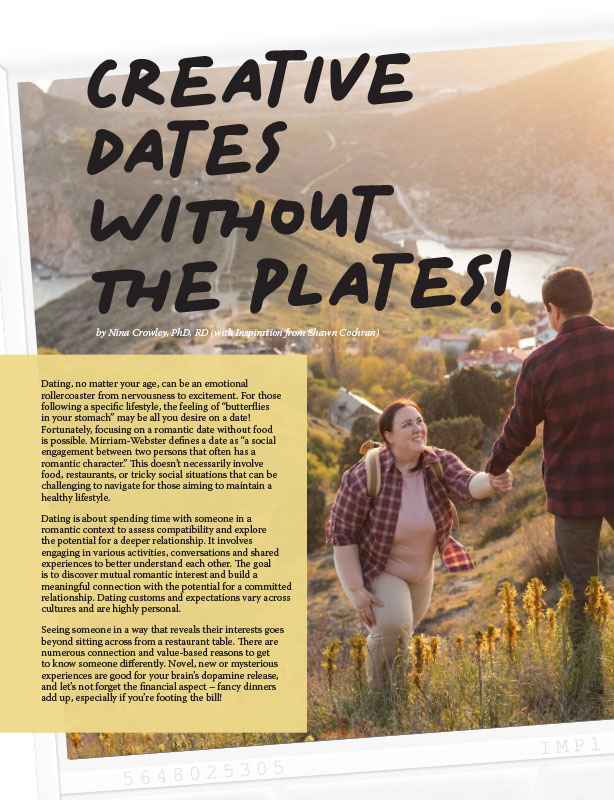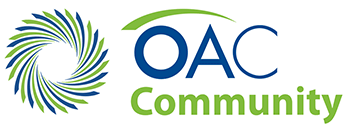Weight-loss: Benefits of Cardiovascular Exercise and Ways to Achieve It

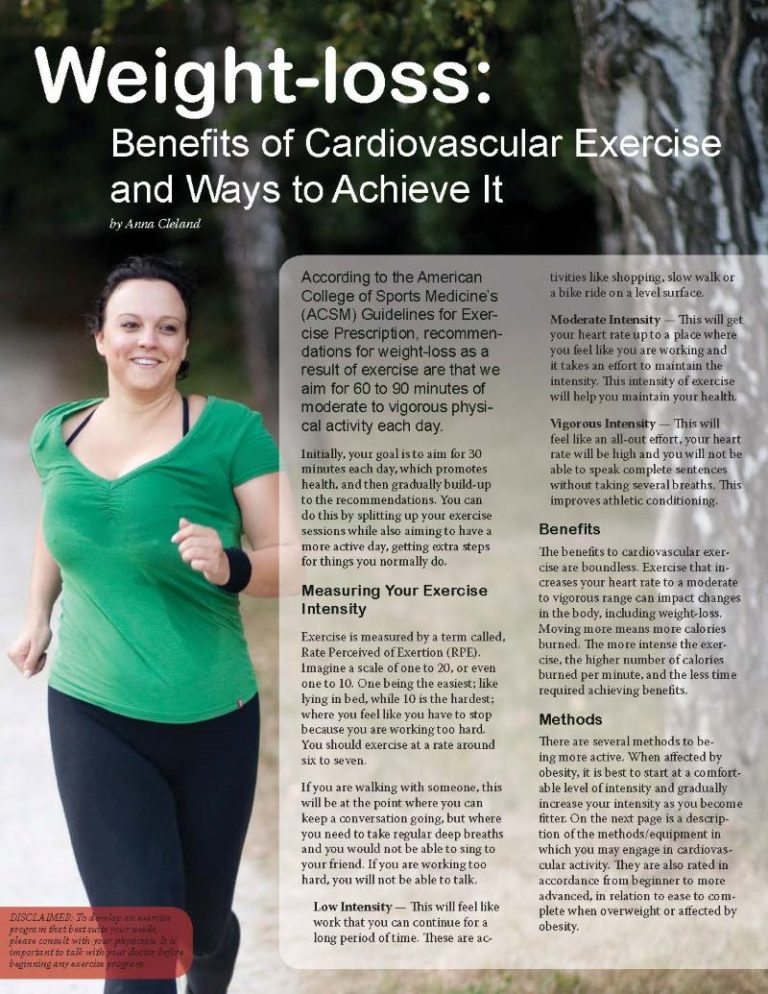
by Anna Cleland
Winter 2012
According to the American College of Sports Medicine’s (ACSM) Guidelines for Exercise Prescription, recommendations for weight-loss as a result of exercise are that we aim for 60 to 90 minutes of moderate to vigorous physical activity each day.
Initially, your goal is to aim for 30 minutes each day, which promotes health, and then gradually build-up to the recommendations. You can do this by splitting up your exercise sessions while also aiming to have a more active day, getting extra steps for things you normally do.
Measuring Your Exercise Intensity
Exercise is measured by a term called, Rate Perceived of Exertion (RPE). Imagine a scale of one to 20, or even one to 10. One being the easiest; like lying in bed, while 10 is the hardest; where you feel like you have to stop because you are working too hard. You should exercise at a rate around six to seven.
If you are walking with someone, this will be at the point where you can keep a conversation going, but where you need to take regular deep breaths and you would not be able to sing to your friend. If you are working too hard, you will not be able to talk.
- Low Intensity — This will feel like work that you can continue for a long period of time. These are activities like shopping, slow walk or a bike ride on a level surface.
- Moderate Intensity — This will get your heart rate up to a place where you feel like you are working and it takes
an effort to maintain the intensity. This intensity of exercise will help you maintain your health. - Vigorous Intensity — This will feel like an all-out effort, your heart rate will be high and you will not be able to speak complete sentences without taking several breaths. This improves athletic conditioning.
Benefits
The benefits to cardiovascular exercise are boundless. Exercise that increases your heart rate to a moderate to vigorous range can impact changes in the body, including weight-loss. Moving more means more calories burned. The more intense the exercise, the higher number of calories burned per minute, and the less time required achieving benefits.
Methods
There are several methods to being more active. When affected by obesity, it is best to start at a comfortable level of intensity and gradually increase your intensity as you become fitter. On the next page is a description of the methods/equipment in which you may engage in cardiovascular activity. They are also rated in accordance from beginner to more advanced, in relation to ease to complete when overweight or affected by obesity.
Cardiovascular Activities and their Levels of Intensity
– Beginner – Intermediate – Advanced
Active Daily Lifestyle (ADL) – Beginner
Examples of this are parking further away, taking the stairs instead of the elevator, walking the dog, gardening, housework, etc. Aim to add daily activity to your life. Wearing a pedometer and aiming for 10,000 steps a day is a way to focus on being more active, while having a goal for each day.
Bike (recumbent, upright, spinning, outdoor – road or mountain) – Beginner to Intermediate
Biking is a form of low impact exercise ideal for beginners and those recovering from surgeries or who have physical limitations. There are many variables to exercising with a bike, and the lowest impact is a recumbent bike – in which you sit level with a backrest and have your feet in front of you. With bikes, you are able to adjust your speed and resistance easily.
Walking/Jogging/Running – Beginner to Advanced
*Walking is the ideal lifetime exercise. It is one of the primary things that our body is dependent on doing. With simply a pair of shoes, you can walk anywhere.
**Jogging is basically slow running; you may be able to jog at a comfortable pace that keeps your heart rate in control. ***Running is different from jogging because of the intensity. The speed is faster, making the activity more intense.
Arm Ergometer – Intermediate to Advanced
This machine looks like a bike for your arms. This is a good way to increase your heart rate when you have extreme limitations with your legs. The intensity can be altered depending on how fast you go or how much resistance you add to the machine.
Treadmill – Beginner to Advanced
The treadmill is essentially your indoor option for walking, jogging or running. The cushioning of the machine tends to be easier on lower extremity joints. The benefit to using a treadmill would be that you can do it indoors, regardless of the weather. You can also vary your intensity depending on how you feel. It is very easy to increase or lower your speed or the incline on a treadmill, and you can slow down if you need to. You can measure your distance and time easily. You are also able to pick a program which would enable you to mindlessly mix up your routine.
Elliptical – Beginner to Intermediate
The elliptical is a machine which is known to be easier on your joints. This is because instead of picking up your foot and stepping back down, you glide your movement through the plane elliptically. Therefore, there is less impact to your joints, and you are able to exercise with a running intensity, without the impact of running. One noticeable limitation to a beginner exerciser might be that the elliptical takes some getting used to and balance may be difficult. But once you become accustomed to it, it may feel easier than other forms of cardio.
NuStep/SCIFIT – Beginner
These two brands of machines are low impact, like a seated elliptical, but designed to favor someone who may have difficulty with balance or standing. They allow you to work only your arms or only your legs, in an elliptical fashion but without standing. This option is highly recommended for someone who has knee or hip limitations.
Water exercise – Beginner to Advanced
Swimming: Swimming is a great form of exercise which can range from leisure to vigorous. It is a low impact exercise for joints, but works every muscle. Walking in the water: If you have difficulty walking on land because of joint pain or weight issues, try walking in the water. The water will help you feel weightless, yet will add resistance to the effort itself. Standing in the water will also aid in balance, if you have any limitations with this. Water aerobics: Water aerobics is a fun way to exercise, giving strength and cardiovascular benefits. This exercise class is perfect for those with weight, age or joint limitations because it is low impact.
Zumba/Jazzercise – Beginner to Intermediate
These are forms of cardio exercise that involve dancing. If you can move your body, you can exercise, and dancing is a fun way to move. Zumba is simple choreography to Latin- themed music. It can be as intense as you want to make it. Every Jazzercise group fitness class combines dance-based cardio with strength training and stretching to sculpt tone and lengthen muscles for maximum fat burn. Choreographed to today’s hottest music, Jazzercise is a fusion of jazz dance, resistance training, Pilates, yoga and kickboxing.
Stairmaster or stairs – Intermediate to Advanced
Stairs are an intense form of cardiovascular exercise because you are working on a continuous incline. With this harder work, you may start with less time, but still reap the benefits as though you went for a longer walk or run.
Sports – Beginner to Advanced
Participating in sports is a great way to socialize while you move your body. Community sports like basketball, tag football, softball, soccer, rugby, Frisbee golf, outdoor adventures like hiking, may all be available in your area.
Exercise videos – Beginner to Advanced
There are great exercise videos available ranging from low intensity to more advanced. A wonderful resource for videos to purchase is www.collagevideo.com. You can find all exercise-related videos created here. There are also free exercise videos on the Web site www.sparkpeople.com.
About the Author:
Anna Cleland is a certified strength and conditioning specialist with the National Strength and Conditioning Association (NSCA), a pink ribbon certified post reconstruction exercise specialist and also member of American College of Sports Medicine (ACSM) and the OAC. She works as the bariatric exercise physiologist for Centennial’s Center for the Treatment of Obesity, in Nashville Tenn., and as a personal trainer for the YMCA of Middle Tennessee.
by Yelena Kibasova Spring 2024 The fitness world is evolving, with new trends and innovations that promise…
Read Articleby Zack Lucks, NASM-CPT, EMT Winter 2024 Working out with a loved one is a great way…
Read Articleby Nina Crowley, PhD, RD (with Inspiration from Shawn Cochran) Winter 2024 Dating, no matter your age,…
Read Article




